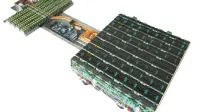Lighter, better battery for small electric vehicles is SmartBatt’s goal

SmartBatt is made up of nine partners from five countries – corporations in manufacturing and technology along with research organizations, including Volkswagen, the Ricardo engineering and consulting company, the SP Technical Research Institute of Sweden, the Austrian Institute of Technology and the Vehicle Safety Institute. Reducing CO2 emissions and slowing down climate change by supporting EVs and “green” electricity are commitments that have been made by the participating countries.
The team says that it’s dedicated to bringing experience and skill sets to cover all aspects of developing advanced battery technologies – vehicle competence, electrics, electronics, batteries, lightweight design, engineering, materials, safety, testing and validation. Whew. Results will be distributed through a project website, papers and training sessions, as well as face-to-face workshops and meetings with OEMs.
The group is working on battery pack design and optimization processes that could deliver a 20-kilowatt hour, 200- to 400-volt pack with a 15-percent reduction in weight compared to current systems and that can deliver a continuous power rating of 36 kw. The consortium says that its concept exceeds the capacity target by more than 10 percent, providing a total of 22.92 kwh of energy storage. A prototype of the battery pack designed for the SmartBatt project was displayed at the European Electric Vehicle Congress that ended November 22.
Like all of the other advanced battery technology projects, it will take a few years for these outcomes to enter the mainstream. But the test results are impressive and having a major engineering company like Ricardo engaged in the process could move it forward faster.
Release date: 19 November 2012
Research by the European ‘SmartBatt’ consortium on the production of next-generation battery technology for electric vehicles is revealed today by Ricardo.
The development of cost-effective, lightweight, high energy density and safe battery technologies is widely considered to be a crucial enabler for the successful and widespread take-up of pure battery-electric vehicles. In order to address this challenge the SmatrtBatt project – a collaboration between nine research partners from five European countries – has sought to develop battery pack design and optimization processes capable of delivering a 20 kWh, 200-400 volt pack with a 15 percent reduction in weight compared with current state-of-the-art systems, while delivering a continuous power rating of 36 kW, and a peak performance of 70 kW for up to 30 seconds. The battery pack delivered by the project exceeds the capacity target by in excess of 10 percent, providing a total of 22.92 kWh of energy storage.
The Ricardo Voltage Temperature Balancing Module on the SmartBatt unitAt the European Electric Vehicle Congress in Brussels – as a part of the European project day programme – a presentation will describe work carried out by Ricardo within SmartBatt to develop design processes that will deliver an optimized battery pack to meet the project’s exacting specification. In addition to its functional requirements and weight reduction target, the team was responsible for the design and assessment of a battery pack offering a range of 120 km based on NEDC operation. The process considered cell selection based on the particular attributes of the target vehicle – assumed to be the size of a VW Golf – and was intended to deliver a solution capable of vehicle integration in a crash-safe manner. The electrical architecture was based on the Ricardo universal battery management system, providing integrated fault detection and charge optimization functionality.
“We were pleased to have been able to participate in the SmartBatt project and to have thoroughly explored many new and innovative approaches to the design and optimization of electric vehicle battery pack systems,” said Dave Greenwood, head of the Ricardo hybrid and electric systems product group. “Through the work presented today, we have been able to demonstrate that a highly optimized pack design, fully integrated with vehicle requirements, is possible using a rigorous flow-down technique based on the application of advanced design software. This work has provided crucial enabling lightweight technology for the next-generation more efficient and functionally attractive electric vehicles.”
A prototype of the battery pack designed by the project is on display at the European Electric Vehicle Congress which runs from today until Thursday November 22.




